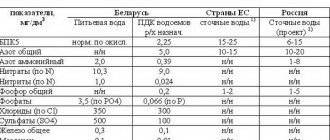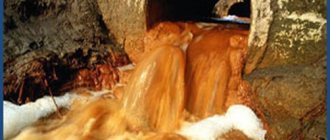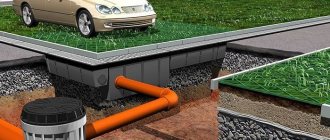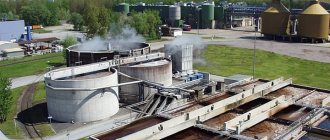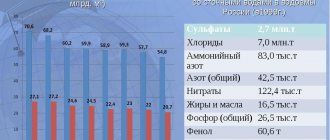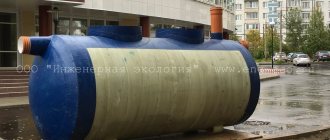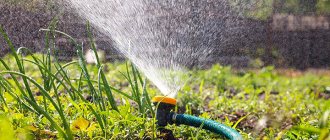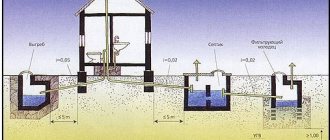The discharge of wastewater onto the terrain is prohibited in 2021 in accordance with the documents:
- Articles 1 and 77 No. 7-FZ dated 10/01/2002 “On environmental protection”
- Order of the Ministry of Natural Resources of Russia dated July 8, 2010 No. 238 “On approval of the Methodology for calculating the amount of damage caused to soils as an object of environmental protection”
- Judicial practice, in particular decision No. 2-125/2015 2-125/2015~M-8/2015 M-8/2015 dated February 11, 2015 in case No. 2-125/2015
In accordance with Article 1 of the Federal Law of January 10, 2002 No. 7-FZ “On Environmental Protection”, the following definitions are given:
- environmental harm – a negative change in the environment as a result of its pollution, resulting in the degradation of natural ecological systems and depletion of natural resources;
- environmental pollution – the entry into the environment of a substance and (or) energy, the properties, location or quantity of which have a negative impact on the environment;
- negative impact on the environment - the impact of economic and other activities, the consequences of which lead to negative changes in the quality of the environment;
- environmental quality – the state of the environment, which is characterized by physical, chemical, biological and other indicators and (or) their combination;
- standards in the field of environmental protection - established standards for environmental quality and standards for permissible impact on it, the observance of which ensures the sustainable functioning of natural ecological systems and preserves biological diversity.
Discharged wastewater may contain various chemicals, including surfactants and phenols, for which environmental quality standards have not been established.
Thus, when wastewater is discharged onto the soil, it negatively changes the quality of the environment, that is, it causes harm to the environment due to its pollution.
In accordance with Article 77 of the Federal Law of January 10, 2002 No. 7-FZ, legal entities and individuals who have caused harm to the environment as a result of its pollution, depletion, damage, destruction, irrational use of natural resources, degradation and destruction of natural ecological systems, natural complexes and natural landscapes and other violations of legislation in the field of environmental protection, are obliged to compensate it in full in accordance with the law.
Environmental damage caused by a legal entity or individual entrepreneur is compensated in accordance with duly approved rates and methods for calculating the amount of environmental damage.
Relief dumping: to be or not to be?
Disposal of wastewater onto the terrain and into drainage ditches is the most ancient method of drainage. Historically, a huge number of natural resource users resort to dumping onto the terrain - from private sector house owners to serious enterprises that find themselves in insufficient reach of both the collector and the water body. However, this aspect of environmental management is not reflected in law.
Doesn't it mean it's allowed?
Initially, the issue was resolved by equating discharge onto the terrain with discharge into a water body, which was normatively enshrined only in the Guidelines for calculating fees for unorganized discharge of pollutants into water bodies (approved by the State Committee for Ecology of the Russian Federation on December 29, 1998). The guidelines were not registered with the Russian Ministry of Justice and, accordingly, were not a document competent to establish the admissibility of dumping onto the terrain (besides, they have now been cancelled).
Other regulatory legal acts contain only requirements for discharge into a water body, but are silent about the possibility of discharge onto the terrain .
The ban on dumping onto the terrain is contained in Resolution of the Moscow Region Government dated December 28, 2009 No. 1162/55 “On approval of requirements for preventing the death of wildlife during production processes, as well as during the operation of transport highways, pipelines, communication and power lines in the Moscow Region” . This prohibition cannot be considered contrary to federal law, because The federal legislator does not talk about the permissibility of dumping onto the terrain.
This prohibition is also based on the fact that relief discharge can actually have a negative impact on the watershed area affected by such discharge, leading to possible waterlogging, flooding and other processes caused by the appearance of additional unorganized discharge.
It is also possible that such a discharge will have a negative impact on the flora and fauna of a given catchment area. It is more difficult to predict the impact in this case than when discharging into a water body.
At the same time, environmental legislation does not distinguish between discharges by individuals and legal entities. The standards are the same for everyone and do not depend on the volume of discharge.
note
Although direct legislative norms prohibiting dumping onto landforms never appeared in federal legislation, the position of government agencies has changed - from equating dumping onto landforms with discharge into a water body to the current unambiguous one: dumping onto landforms leads to unacceptable from the point of view of the Land Code of the Russian Federation to flooding, waterlogging, and, if environmental quality standards are not observed, to soil pollution.
Discharge onto the terrain may become the basis for prosecution (under Article 8.6 “Damage of land” of the Code of Administrative Offenses of the Russian Federation[1]) or even a claim for compensation for damage to soils . This position is now common in relation to production and other activities of legal entities and individual entrepreneurs.
We believe that, if it particularly desires, a government agency can apply it to individuals. Similar judicial practice for individuals has not been identified, perhaps due to the fact that fines for citizens under Art. 8.6 of the Code of Administrative Offenses of the Russian Federation are small (from 3 to 5 thousand rubles).
It is worth saying that recovery of compensation for damage to soils from individuals does occur. An example of this is the recovery of damage to soil caused by a spill of wastewater when a concrete well overflowed, where an individual (the owner of a private house) diverted household wastewater for accumulation (see the Appeal ruling of the Supreme Court of the Chuvash Republic dated May 13, 2020 in case No. 33-2103/ 2020).
Pump out and remove
Strict requirements for discharges are imposed on owners of land plots in protected zones (sanitary protection zones, water protection zones of water bodies), up to a complete ban on discharges. In these areas it is necessary to carry out complete pumping and removal of wastewater.
Construction legislation contains provisions on the possibility of discharge “using natural treatment methods.” In other words, this is a dump onto the terrain, but through engineering structures.
This provision is contained in SP 32.13330.2018 “Sewerage. External networks and structures":
9.2.13.2. It is allowed to use natural methods of wastewater treatment (irrigation fields, underground filtration fields, filter wells and trenches, biological ponds, etc.) from objects, with appropriate justification: favorable soil conditions, low groundwater levels, reliable protection of groundwater and water sources from pollutants, satisfactory climatic conditions.
As follows from the above norm, the specified discharge is possible only if certain conditions are met, incl. when justifying the reliability of protecting groundwater and water sources from pollutants in accordance with the Order of the Government of the Russian Federation dated July 8, 2015 No. 1316-r “On approval of the list of pollutants in respect of which state regulatory measures in the field of environmental protection are applied.”
Consequently, the possibility of such a discharge is available only for conditionally clean discharges. In practice, these are drainage effluents and effluents from the last stage of domestic wastewater treatment.
However, the most reliable option, due to the unambiguous position of government agencies regarding dumping onto the terrain, is complete pumping and removal of wastewater.
On environmental forums on the Internet, aimed at legal entities, the unambiguous ban on dumping on terrain is discussed. On construction forums on the Internet, the possibility of discharge through engineering structures, after septic tanks (they do not take into account the environmental side) is discussed based on the absence of obvious pollution and flooding (for example, discharge into depressions in the relief, ravines, reservoirs).
Nature user - who is he?
Judicial practice reveals a case involving the discharge of household wastewater from the houses of a gardening non-profit partnership (SNT) into a roadside drainage ditch. The defendant is SNT, not individuals. The court resolved the situation by recognizing a violation of the procedure for bringing to justice, i.e. did not speak out on the merits (see Resolution of the Tenth Arbitration Court of Appeal dated February 24, 2014 in case No. A41-60368/13).
So far, claims have been made against individuals only in the case of complaints from neighbors. That's why they're alive. Because if you try to organize a legitimate drainage system on your site, you are faced with the fact that only the removal of liquid waste is legitimate. Imagine removing waste from the shower, kitchen, toilet... How much will it cost? It is clear that no one does or can do this.
In relation to discharge into a water body, the legislation uses the term “user of natural resources”, and not “legal entity and individual entrepreneur”. It turns out that if an individual discharges his wastewater into a water body, he will have to obtain a discharge decision and fulfill all the requirements related to this. This is also unrealistic for an individual.
According to the logic of the legislation, water disposal must be organized by the local government, which it fails to do everywhere, as a result of which the norms and judicial practice regarding the responsibilities of local governments look streamlined.
We believe that where a local government body is not able to sewer its territory, it should at least decide on the rules of sewerage, down to the requirements for septic tanks.
For example, there are now septic tanks on the market with a declared degree of purification of 98%. These are “Topaz”, “Eurobion”, “Astra”, “Tver”, etc.
If the authorized bodies formulated clear requirements for septic tanks, then it would be possible to certify them for compliance with these requirements.
Another option would be for the local government to approve the installation of the septic tank and the discharge point. This would be even more correct. For now, it turns out in accordance with the general situation in the country, when an official has two tasks: to cover himself and to show himself. As part of the first task, no one will take responsibility for coordinating the installation of a septic tank and the discharge point. As part of the second task, they will come to fine you and charge for damage to water and soil, and that’s millions of rubles.
As a result, everyone living in the private sector is a violator of the law.
We believe that in terms of water disposal, this situation can be correctly prevented by obliging municipal administrations, with the involvement of expert resources, to develop specific and enforceable water disposal rules for the private sector and to coordinate newly installed systems and discharge points.
Theoretically, this is the sphere of housing and communal services, and the standard rules for improvement, which prescribe drainage from residential buildings, have been approved by the Ministry of Construction of Russia[2]. However, they only say that liquid waste cannot be poured into drainage systems. Are ditches dug along the site classified as drainage systems, and effluent from a septic tank classified as liquid waste?
The separation of “wastewater” and “liquid waste” is based on the method of their disposal. Accordingly, if you pour it into the drainage system, it is already waste water. And the “system” seems to be some more “systemic” phenomenon, at least, for example, on the balance sheet of a local government body. The ditches, dug everywhere along private houses, were dug in historically immemorial times and are not on anyone’s balance sheet.
The decision is at the top
As we can see, all over the country various wastewaters are being discharged onto the terrain. The private sector makes a large contribution to this discharge. This issue is settled only by prohibitive norms of “no”, and there are no norms that answer what can be done in proportion to reality. In this regard, it is advisable to immediately create a legal scheme for dumping onto the terrain, regardless of the type of runoff. The scheme must take into account economic realities and types of natural resource users.
In the meantime, from the explanations of the law enforcement officer, it follows that the discharge should only be into a sewer or into a water body . It turns out that the user of nature, located far from the sewerage system and water body, is obliged to lay a pipe to the sewerage system or water body. In the practice of our company, such solutions were proposed for enterprises located in existing buildings at a distance of 5–12 km from a water body.
Since it turns out that for everyone, without exception, legitimate discharge is possible only into water bodies subject to the execution of permits, both individuals and business entities (legal entities and individual entrepreneurs), who historically discharged wastewater onto the terrain and are now unable to lay a pipe to the water object found themselves outside the legal framework.
In this regard, the situation with dumping onto the terrain must be resolved simultaneously for all subjects of legal relations.
[1] Code of the Russian Federation on Administrative Offences.
[2] See Order of the Ministry of Construction of Russia dated April 13, 2017 No. 711/pr “On approval of methodological recommendations for the preparation of rules for the improvement of territories of settlements, urban districts, and intra-city areas.”
Trap for nature users
There are often cases when users of natural resources complain that they are prevented from organizing wastewater filtering devices at their economic or industrial sites:
- high groundwater level;
- lack of free space.
In this case, they use a low-lying landscape area, with the confidence that it is possible to discharge wastewater onto the terrain.
But where did such confidence come from? To take a phrase about allowing such an action in printed publications or on the pages of Internet sites without linking it to a specific regulatory document would be reckless.
It’s also good that in frequently occurring permitted phrases, they ask not to forget about the standards set for the quality of discharged water.
Again, where can we get the standards if, in fact, it is prohibited to discharge wastewater onto the terrain?
A rather dubious assertion comes to the rescue that wastewater standards coincide with the discharge of used water into reservoirs.
Attention. To what extent this is true, we have to figure out so that such a permitted “trap” does not become a trial or payment of fines for nature users for causing harm to the environment in the form of the spread of contaminated wastewater throughout the area.
Scheme of modernity
In addition to the current topic described above, I would like to describe a modern scheme for draining used water onto the terrain:
- Domestic and household wastewater is treated using biological or mechanical wastewater treatment equipment.
- Surface drains undergo mechanical treatment.
- The discharge of wastewater into the area occurs at a permanent discharge point.
In order to calculate the volume of discharges onto the terrain, it is necessary to carry out comprehensive PEC (industrial and environmental control) procedures.
They include:
- visit of specialists to the site;
- testing of wastewater;
- sample preservation;
- filling out the necessary documents;
- analysis of waste samples;
- issuance of an analysis protocol indicating quantitative and chemical indicators;
- determination of waste volumes.
Carrying out PEC procedures and subsequently obtaining permission requires significant funding.
As we described above, equating discharges onto terrain with water bodies is not supported by legitimate documents.
As a result, tax authorities or independent audit organizations may have questions about the illegal basis for carrying out discharges and paying for these actions.
Therefore, choosing the right path is only in your power.
Rules for receiving wastewater into the city network
Requirements for the acceptance of wastewater into the city sewerage network are determined by a regulatory document that defines the rules for the acceptance of used industrial waters into the sewerage network of settlements.
Basic principles of reception:
- joint collection of industrial and domestic waters is advisable if the former requires treatment and they can be jointly purified by biological or mechanical treatment at city treatment facilities;
- the discharge of wastewater should not lead to disruption of the network operation, the formation of blockages or toxic gases;
- wastewater disposal should not allow pathogenic bacteria to enter the city sewer system, and not disrupt the operation of cleaning devices.
The list of facilities that have the ability to discharge wastewater into the city network is determined by water supply and sewerage organizations.
They are responsible for calculating the permissible concentration of wastewater pollution.
To date, a procedure has been defined for monitoring compliance with the requirements for the reception of wastewater.
It includes the following activities:
- carrying out laboratory control of wastewater;
- identification of unorganized discharges exceeding the content of pollutants;
- imposition of penalties upon detection of violations.
Rules for receiving wastewater into the drainage network
Reception of wastewater
To ensure stable operation of the drainage system and prevent its destruction when interacting with negative substances, wastewater collection occurs in compliance with certain rules and requirements:
- it is allowed for wastewater to enter the drainage network only through receiving devices that are equipped with a water seal;
- it is allowed to receive wastewater into the rainwater network through storm water inlets;
- Reception of industrial wastewater is allowed into the drainage network if this does not lead to disruption of the network and treatment facilities.
At the same time, production waste must:
- do not contain suspended impurities in quantities of more than 500 mg/l and other substances that clog pipes:
- not have a destructive effect on the elements of structures and materials of the system;
- do not contain gaseous substances or hot impurities. Promoting the formation of explosive mixtures;
- do not exceed the temperature more than 40 degrees.
It is not allowed to discharge wastewater into the drainage network:
- with the presence of mineral contamination;
- different types of wastewater that form toxic gases when mixed;
- containing bacterial contaminants;
- non-disinfected used water from poultry farms and meat processing plants;
- remaining after washing vehicles in garages (with the exception of a general alloy network).
The used water that enters the drainage network must be neutralized and conditionally clean, the purification rate of which is determined by the sanitary inspection authorities.
Wastewater that does not meet the described requirements must undergo preliminary treatment at local treatment facilities.
